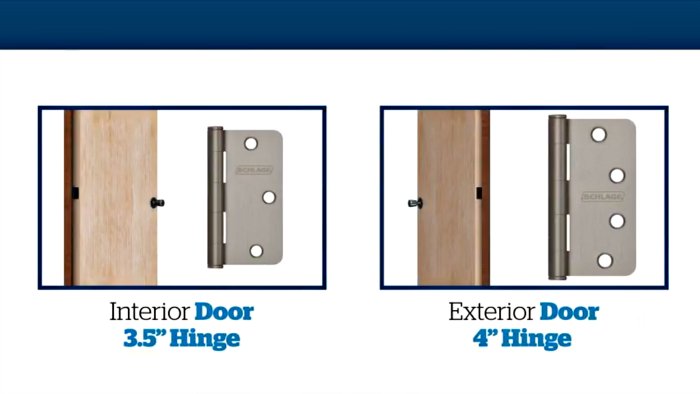
So, how do you go about it? Think of it like finding the right puzzle piece to fit into a specific spot in your home. You want to ensure it’s the exact match not just for size, but also for your door’s style and function. Maybe you have a specific brand in mind, or you might have stumbled upon a few options at your local hardware store. Either way, getting the right door hinge matters more than you may realize!
Understanding Door Hinges
Before diving into identification methods, it’s important to understand what a door hinge really is. Essentially, a door hinge is a type of mechanical device that connects the door to the door frame, allowing it to swing open and closed. Most residential doors use either butt hinges, continuous hinges, or pivot hinges.
Butt hinges are the most common and resemble two plates that are joined by a pin. Continuous hinges run the length of the door and provide even support. Each of these types comes in various sizes and materials, which means that not every hinge will work for every door.
You might be wondering what factors to consider when replacing a hinge. Here are some essentials:
- Size: The height and width of the hinge are crucial for proper fitting.
- Material: Hinges come in different materials, like brass, stainless steel, or zinc-plated steel. Make sure to consider the durability.
- Style: Some hinges have special designs that match modern or traditional decor.
How to Measure Your Current Hinges
If your hinge is worn out, measuring it accurately is the first step toward finding a suitable replacement. You’ll need a tape measure for this task. Here’s a simple way to do it:
1. Remove the Hinge: Use a screwdriver to carefully take off the hinge from your door. Lay it flat on a surface.
2. Measure the Height and Width: For butt hinges, measure the height (usually the longer side) and width (the shorter side) in inches.
3. Check the Hinge Thickness: This is often less obvious but can impact the fitting. Measure the thickness of the hinge plates.
Don’t forget to note the screw hole distance as well. This is the distance between the holes where screws attach the hinge to the door and frame. It’s vital to ensure the new hinge aligns perfectly.
Identifying the Brand and Model
Once you’ve got your measurements, the next step is identifying the brand of your door hinge. Often, the brand name is stamped on the hinge itself. Here’s how to go about this:
– Check for Labels: Look for any labels or stamps on the hinge. Some brands even print their model numbers.
– Look Up Information: If you can see the brand name, it’s easier to search online for replacement options specific to that brand. A quick search on the manufacturer’s website or a conversation with a local hardware store can yield great results.
– Documenting: If you’re unable to identify the brand through physical markings, take a clear photo of the hinge and use it for reference when asking for help.
Exploring Online Replacement Options
With your measurements and brand details in hand, it’s time to explore your options. Online marketplaces like Amazon, eBay, or specialty hardware sites can be very helpful. Here are some steps to make your search easier:
1. Use Specific Search Terms: Instead of just searching for “door hinge,” include the brand name and dimensions. For example, “Schlage door hinge 4-inch.”
2. Read Reviews: Check customer reviews to see if people had a good experience with the hinge and if it fit correctly.
3. Check Return Policies: Should something go wrong, a flexible return policy can save you a lot of hassle.
Shopping online can be overwhelming with countless options available. But having specifics down will help you navigate easily.
Considering Universal or Alternative Hinges
If you can’t find the exact hinge, consider universal or alternative options. Universal hinges are designed to fit a variety of doors and might come in adjustable sizes. Here’s what to keep in mind:
– Installation Ease: Universal hinges often come with straightforward instructions and easy installation methods.
– Durability: While they may not have the brand-specific appeal, many universal options are just as durable and effective as brand-name hinges.
– Aesthetic Choice: Depending on your style, you might find that an alternative or universal hinge can blend in just as well with your existing decor.
But remember, if your door is under warranty, using a non-brand hinge could void that warranty, so always check first!
Reinstallation and Maintenance Tips
Once you have your replacement hinge, it’s time for reinstallation. Here’s a quick guide to help ensure a smooth process:
1. Align the Hinge Correctly: Ensure the hinge is flush against the door and frame.
2. Secure with Screws: Use a power screwdriver to tighten the screws, but be careful not to overtighten and strip the holes.
3. Test the Door: Open and close the door to test the hinge’s function. Make adjustments if necessary.
Keeping your hinges in good shape is also important for longevity. Regularly check for rust or wear and lubricate them every six months to keep everything running smoothly.
Identifying and replacing a door hinge might seem like a small task, but it’s one that can make a big difference in the smooth operation of your door. From measuring and identifying brands to exploring online options and proper installation, each step is part of the puzzle.
Remember to measure carefully, consider all your options, and don’t hesitate to ask for help when needed. By following these guidelines, you can ensure that your replacement door hinge fits perfectly and keeps your door swinging smoothly for years to come. Happy repairing!